

Biopharming. Since the early 1990s, biotech companies have proposed using food and feed crops as miniature factories for producing pharmaceutical proteins and industrial chemicals that they do not make naturally.
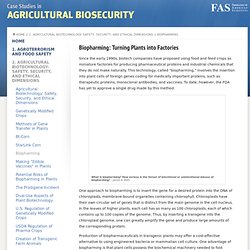
This technology, called “biopharming,” involves the insertion into plant cells of foreign genes coding for medically important proteins, such as therapeutic proteins, monoclonal antibodies, and vaccines. To date, however, the FDA has yet to approve a single drug made by this method. One approach to biopharming is to insert the gene for a desired protein into the DNA of chloroplasts, membrane-bound organelles containing chlorophyll.
Chloroplasts have their own circular set of genes that is distinct from the main genome in the cell nucleus. Genetically Modified Crops. For centuries, farmers have bred crops for certain desirable traits.
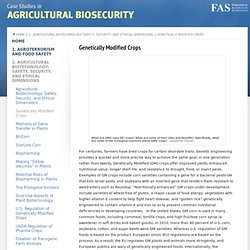
Genetic engineering provides a quicker and more precise way to achieve the same goal, in one generation rather than twenty. Genetically Modified (GM) crops offer improved yields, enhanced nutritional value, longer shelf life, and resistance to drought, frost, or insect pests. Examples of GM crops include corn varieties containing a gene for a bacterial pesticide that kills larval pests, and soybeans with an inserted gene that renders them resistant to weed-killers such as Roundup. “Nutritionally enhanced” GM crops under development include varieties of wheat free of gluten, a major cause of food allergy; vegetables with higher vitamin E content to help fight heart disease; and “golden rice” genetically engineered to contain vitamin A and iron so as to prevent common nutritional deficiencies in developing countries. Case Studies in Agricultural Biosecurity. This set of educational modules is intended to raise awareness about agricultural biosecurity issues in the United States and is targeted towards the educated public.
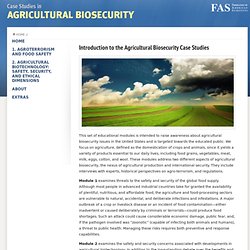
We focus on agriculture, defined as the domestication of crops and animals, since it yields a variety of products essential to our daily lives, including food grains, vegetables, meat, milk, eggs, cotton, and wool. These modules address two different aspects of agricultural biosecurity, the nexus of agricultural production and international security. They include interviews with experts, historical perspectives on agro-terrorism, and regulations. Module 1 examines threats to the safety and security of the global food supply. Although most people in advanced industrial countries take for granted the availability of plentiful, nutritious, and affordable food, the agriculture and food-processing sectors are vulnerable to natural, accidental, and deliberate infections and infestations.
August 2013. The mid to late 1800s was a very difficult time for the European wine grape industry.
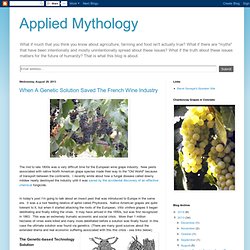
New pests associated with native North American grape species made their way to the "Old World" because of transport between the continents. I recently wrote about how a fungal disease called downy mildew nearly destroyed the industry until it was saved by the accidental discovery of an effective chemical fungicide. An Error Occurred Setting Your User Cookie. This site uses cookies to improve performance.

If your browser does not accept cookies, you cannot view this site. Setting Your Browser to Accept Cookies There are many reasons why a cookie could not be set correctly. Below are the most common reasons: You have cookies disabled in your browser. Why Does this Site Require Cookies? This site uses cookies to improve performance by remembering that you are logged in when you go from page to page. What Gets Stored in a Cookie? This site stores nothing other than an automatically generated session ID in the cookie; no other information is captured.
05BasuGMC1-2. Standing Up for GMOs. + Author Affiliations On 8 August 2013, vandals destroyed a Philippine “Golden Rice” field trial.
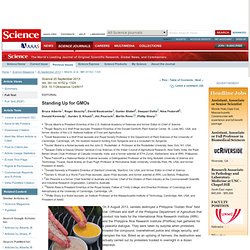
Officials and staff of the Philippine Department of Agriculture that conduct rice tests for the International Rice Research Institute (IRRI) and the Philippine Rice Research Institute (PhilRice) had gathered for a peaceful dialogue. AMSv1. New study of GM maize is controversial in scientific circles - News. Sep 21, 2012 News Print Send Add comment Long-term feeding study with rats According to the results of a long-term feeding study at the University of Caen in France, genetically modified NK603 maize and the herbicide Roundup lead to severe health problems in rats.

Jenny asks: How does Agrobacterium-mediated gene transfer work? GMO Compass. GMO Database - Authorisation and approval status in the EU. Is genetic engineering ever going to take off in forage, turf and bioenergy crop breeding? Transformation of Tropical Maize with the <i>NPK1</i> Gene for Drought Tolerance. A Plant Scientist’s perspective on bill 113. A Puna papaya farm, Credit: KJHvM Today, the Hawai’i County Council will hear testimony concerning bill 113, which seeks to ban or limit most genetically engineered plants on the island.

The bill is a successor to bill 79, which was withdrawn. While Kaua’i county debates the production of GMOs and the spraying of pesticides, the Big Island stands alone in debating a bill solely about genetically engineered crops. Bill 113 would ban the cultivation of genetically engineered plants in the open air, except for papayas and other crops that specific people or organizations have grown on a location in the past. For instance cattle farmers who grow genetically engineered corn would still be able to do so, while other farmers who haven’t been growing them yet across the street would be barred from adopting them. APP201381_EPA_Advice_Document.